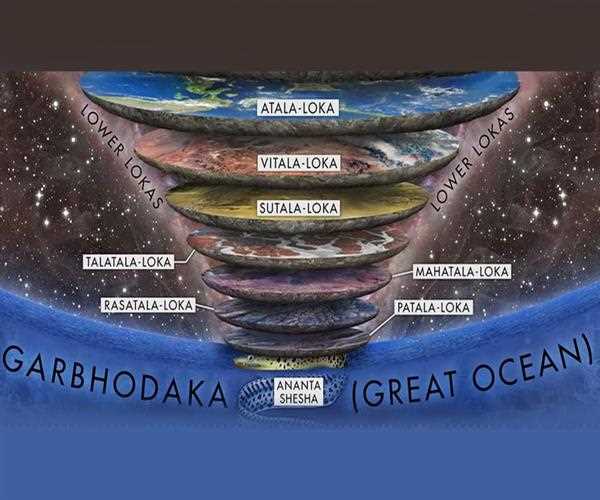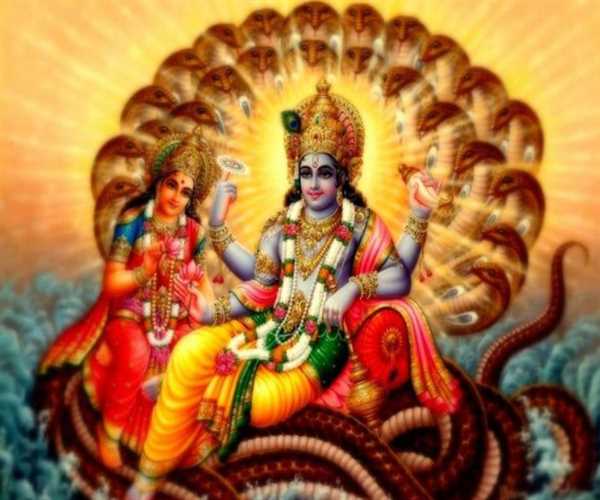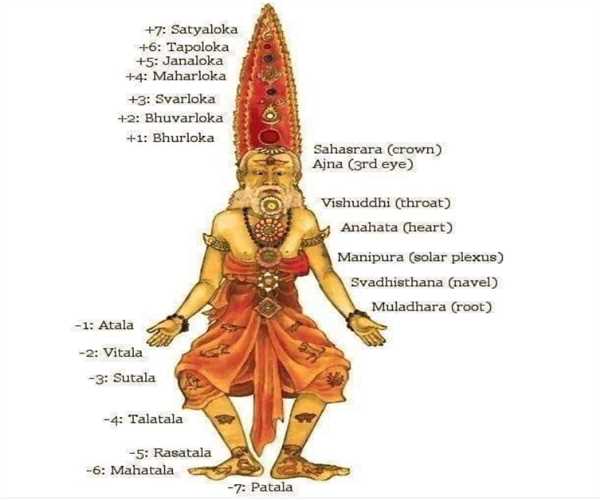
16-Oct-2023 , Updated on 8/25/2025 4:25:49 AM
Science behind 14 lokas in hinduism
The Hindu scriptures describe the 7 lokas beyond the earth as Bhu, Bhuva, Suva, Maha, Jana, Thapa, and Satya Loka. Every door leads to a higher level of loka/gate, and upon entering the 7th door, you arrive at Satya Loka, the dwelling place of Brahman or Lord Vishnu . All religions acknowledge the presence of GOD in this divine realm known as Moola, the origin.

The Geo-centric model forms the foundation of this ancient concept.

There are seven lokas beneath the earth known as Atala, Vitala, Sutala, Talatala, Maha tala, Rasatala loka, and Patala loka.
One possible explanation for the concept of seven heavens/gates could be the presence of seven ancient planetary systems arranged in a circumpolar manner within the Axis Mundi concept. We structure our lives according to a 7-day week because it aligns with the historical recognition of seven celestial bodies that exist above us. This arrangement of seven day structure is also present in the creation stories of the Greeks, Hinduism, the Book of Genesis, and other popular myths. During ancient times, people could observe seven celestial objects without the use of any instruments – namely, the Sun, Moon, Mars, Mercury, Jupiter, Venus, and Saturn.
The Axis Mundi, also known as Mount Meru or Lingam, is depicted in numerous ancient texts as the central axis around which the entire universe revolves. The Big Dipper, Draco, the Sun, Moon, and Stars humbly encircle the sacred Mount Meru or the Shishumara Planetary system in reverence. In the framework of Egyptian ideology. A clever comparison for the afterlife is using the concept of Circumpolar Stars, as they constantly revolve around the pole star without ever appearing to disappear below the horizon. These celestial bodies are everlasting, also known as the "Immortals" according to ancient Egyptian language, providing the ideal resting place for the deceased monarch's spirit.
The renowned ancient Indian astronomer, VārāhaMihira, in his works Pancha-Siddhāntikā and the Suryasiddhanta, designated the North Pole and the 'Navel of the Earth' as the sacred location of Meru.
Several famous Buddhist and Hindu temples have been constructed as symbolic representations of this mountain, while numerous legends have been connected with this sacred peak. According to Hindu Puranas, it is stated that the Gods dwell in the northern direction. Referring to Lord Brahma's day and night, it is stated that one human year is equivalent to one day for him. This notion draws upon the concept that the North Pole experiences six months of continual sunlight, followed by six months of constant darkness, resulting in a year-long cycle of day and night.
Moreover, within Hindu customs, the swastika symbol (卐) is recognized as a representation of arms directed in a clockwise direction. In the search for the ancient Ramayana verse regarding 'Dhruvam serve Pradakshinam', it is mentioned that Dhruvam denotes the pole star, and the seven sages (Saptarishis) known as the Big Dipper carry out the Pradakshinam. The term "swastika" originates from the Sanskrit term "swasti." This word is formed via a combination of n

Su is a term used to describe something that is positive, beneficial, or fortunate. It signifies goodness, and wellness, and is associated with auspiciousness.
Asti, an ancient Sanskrit word, signifies the state of existence or the presence of something.
Many Hindu rituals, such as circumambulating around deities, temples, and sacred hills, as well as performing circumambulation around the sacred fire during marriage ceremonies, are deeply connected to the cosmology of Hinduism.
The Egyptian pyramids were expertly aligned with the North Pole star (Thuban), specifically during the time period of 2800 to 2000 BCE.
The Vitruvian Man encompassed 14 divisions, each symbolizing a shared truth, reminiscent of the Purusha concept observed in the ancient Vedas.
All of these are created as a single Brahmanda. The creation is manifested by Brahma as a representative of Paramatma. According to the Vedas, prior to its formation, it resembled a coconut with its entire shell intact. Acharyas have passed down this information through tradition. When the time comes for Paramatma or Parabrahmam to bring about the destruction of these worlds, Rudra will manifest. After being devastated, he rests in the depths of the water for countless billions of years.
He is unsure about his preferred waking time. The Vedas have communicated this information. When He awakens, the manifestation of Nature (referred to as Avyaakrutham, Prakruthi, or Maya) becomes disrupted, prompting the commencement of creation once more. This constitutes a recurring pattern. It possesses an extent that exceeds our numerical ability to measure. Only the Vedas and Puranas are capable of describing these timelines. The Vedas are the sole evidence of all these occurrences.
To accomplish their aspirations and objectives, individuals must diligently adhere to Sasthras or seek guidance from knowledgeable elders who are well-versed in them. The Bhagavad Gita expressed the same idea. People have the option to choose their desired destination from the various Lokas available. Choosing a career path, such as being a doctor, engineer, or collector, can be likened to this decision. However, the outcome is ultimately determined by the divine authority. If an individual seeks liberation from the cycle of rebirth, they transcend the boundaries of the 14 Lokas.
By attuning your mental state to these Lokas, you experience a decrease in weight due to existing as a dominant ethereal being with minimal physical mass. So, in this expedition to All Lokas, there are no rules or principles of matter or physics that are relevant. Although there is still much progress to be made, it is widely acknowledged that Vedic science has a significant role to play in advancing knowledge in this field.
If you include something in its entirety, the entirety will still remain unchanged. due to the insignificance of something in relation to the entirety
Om Purnamadah Purnamidam Purnat Purnamudachyate Purnasya Purnamadaya Purnameva VashishyateThe strong connection between the physical Lokas and Dhyana yoga mind state allows for an enjoyable and limitless journey, transcending material boundaries.
The concept of the mind controlling the body implies... The body is influenced by the thoughts that the mind generates, whether they are positive or negative. If your mind is focused solely on a goal, your body must make sacrifices in order to align with it, regardless of good or bad outcomes. Therefore, your mind will not be burdened by the weight of any material object. The mind assimilates and encompasses everything.In Satya Lok, both Brahma and Saraswati find their dwelling place.
The Loka can be reached by tapping into one's highest level of consciousness, engaging in pure actions through Dhyana yoga, avoiding any distractions from the material world and its influences.
This function is where the transformation of subtle bodies occurs, turning them into spiritual bodies.
The final destination of all spiritual beings is Vaikuntha Loka, located approximately 26,200,000 yojanas

SEO and Content Writer
I am Drishan vig. I used to write blogs, articles, and stories in a way that entices the audience. I assure you that consistency, style, and tone must be met while writing the content. Working with the clients like bfc, varthana, ITC hotels, indusind, mumpa, mollydolly etc. has made me realized that writing content is not enough but doing seo is the first thing for it.
Comments
Join Our Newsletter
Subscribe to our newsletter to receive emails about new views posts, releases and updates.
Copyright 2010 - 2025 MindStick Software Pvt. Ltd. All Rights Reserved Privacy Policy | Terms & Conditions | Cookie Policy